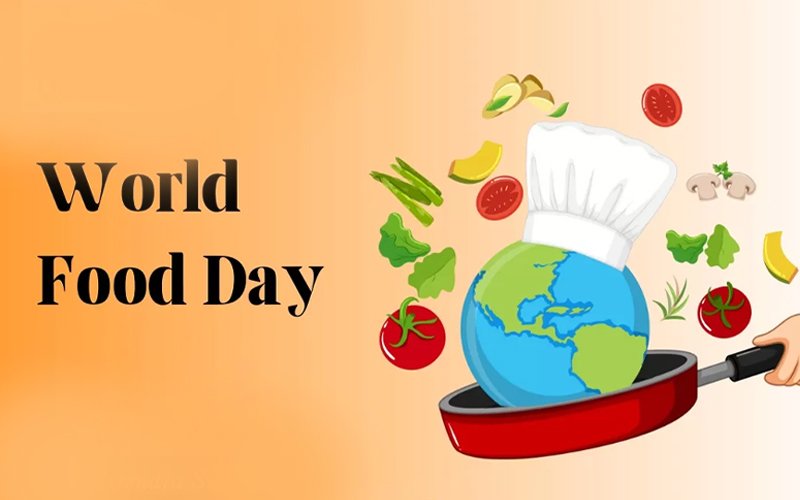October 16 is observed as World Food Day by the United Nations Food and Agriculture Organisation (FAO) to reinforce global commitments to food and nutritional security. It serves as a reminder of the substantial progress made in increasing food production through improved agricultural practices, including better seeds, irrigation, and efficient farm machinery. However, challenges remain, with approximately 2.33 billion people facing moderate to severe food insecurity, as reported by the State of Food Security and Nutrition in the World (SOFI).
The theme for this year’s World Food Day is “Right to Foods for a Better Life and a Better Future.” The concept of the Right to Food played a pivotal role in the passage of the National Food Security Act (NFSA) in India in 2013, aimed at providing subsidized food to about two-thirds of the population.
India's Role in Global Food Security:
- Today, India stands as a food surplus country, being the largest producer of milk, pulses, and spices, and the second largest producer of food grains, fruits, vegetables, cotton, sugar, tea, and farmed fish. India's transformation from a global food security concern to a provider of solutions for global food and nutrition security underscores its valuable experience in food system transformation, which is poised to benefit the Global South.
- However, the global perspective on food security in low and middle-income groups paints a troubling picture, with India being no exception. In the Global Hunger Index 2024, India was ranked 105th out of 127 countries.
- A staggering 55.6% of India's population is unable to afford a healthy diet, amounting to 788.2 million people—the highest in Asia. India's public spending on food and nutrition ranks among the lowest globally, leading to significant contributions to the number of undernourished individuals. This situation is exacerbated by stagnant levels of moderate and severe food insecurity, which have remained at 24.8% since the pandemic.
- The FAO’s latest estimates indicate a slight decline in hunger in India, from 14% during the pandemic years (2020-22) to 13.7% (2021-23). Nevertheless, these figures remain considerably higher than pre-pandemic levels, where chronic hunger affected only 10.3% of the population in 2014-16. Alarmingly, the number of individuals suffering from chronic hunger in India increased by 5 crore between 2014-16 and 2021-23.
Government initiatives for food security:
India has made significant strides in enhancing food security, particularly through several key government initiatives:
1. The National Food Security Act (NFSA): This act entitles up to 75% of the rural population and 50% of the urban population to receive subsidized food grains through the Targeted Public Distribution System (TPDS), covering approximately 81 crore beneficiaries. This includes both Priority Households (PHH) and Antyodaya Anna Yojana (AAY) categories, with a focus on empowering women, as 16 crore women are among the beneficiaries.
2. Pradhan Mantri Garib Kalyan Anna Yojana (PMGKAY): Launched to mitigate hardships faced by the poor during the COVID-19 pandemic, this scheme will be extended for an additional five years starting January 1, 2024, providing free food grains to about 81.35 crore beneficiaries.
3. PM POSHAN (POshan SHAkti Nirman) Scheme: Aimed at improving the nutritional status of children in government schools, this program has a financial outlay of ₹130794.90 crore for the period 2021-22 to 2025-26, with a focus on encouraging school attendance among disadvantaged students.
4. Antyodaya Anna Yojana (AAY): This initiative targets the most vulnerable segments of society, currently supporting over 8.92 crore individuals, with a particular emphasis on women.
5. Overview of Rice Fortification in India: Since the 2019-20 fiscal year, approximately 406 lakh metric tonnes of fortified rice have been distributed through the Public Distribution System (PDS) to enhance nutritional value.
6. Government Actions on Price Stability and Affordability: To manage price volatility, the government has utilized the Price Stabilization Fund (PSF), significantly increasing the onion buffer from 1 LMT in 2020-21 to 7 LMT in 2023-24. New initiatives such as Bharat Dal, Bharat Atta, and Bharat Rice offer subsidized prices, ensuring affordability for lower-income groups.
Critiques of the Current Food Security Framework:
1. Economic Rationality: Providing highly subsidized food to a vast segment of the population is economically unsound. The previous Atal Bihari Vajpayee government implemented a more targeted approach to food subsidies, prioritizing the most vulnerable groups. The article suggests that current practices may serve more as political strategies than genuine welfare initiatives.
2. Poverty Measurement: The NITI Aayog's Multi-dimensional Poverty Index indicates a significant drop in the poverty ratio from 29.13% in 2013-14 to 11.28% in 2022-23. Given this decline, the rationale for distributing free food to over 800 million people is questioned, prompting calls for reform in subsidy practices.
3. Inefficiencies in Subsidy Distribution: Research by ICRIER highlights substantial inefficiencies, with nearly 25-30% of food and fertilizer subsidies failing to reach intended beneficiaries. This leakage could amount to 40-50% of the total resources allocated, undermining the goals of food security initiatives.
Way Forward:
- Digitisation of the Agri-Food System: Implementing digital solutions can create a more efficient and accountable distribution system.
- Targeted Subsidies: A focused approach should be adopted, where free food is provided to a limited percentage of the population, while others are encouraged to pay a fair price for food.
- Rationalising food subsidies could lead to better investment in agriculture, such as research and development, precision farming, and education, which are crucial for achieving sustainable food security by 2030.
Conclusion:
In summary, while World Food Day emphasizes the global commitment to ensuring food security, it also highlights the need for effective and economically sound policies that can adapt to the changing landscape of poverty and agricultural practices. By reforming current subsidy systems, the Indian government can enhance agricultural productivity and resilience, ultimately working towards the Zero Hunger goal outlined in the Sustainable Development Goals (SDGs).
|
Probable questions for UPSC Mains exam: In what ways does the Indian government's approach to international food security assessments impact the country’s ability to address hunger and malnutrition? |








